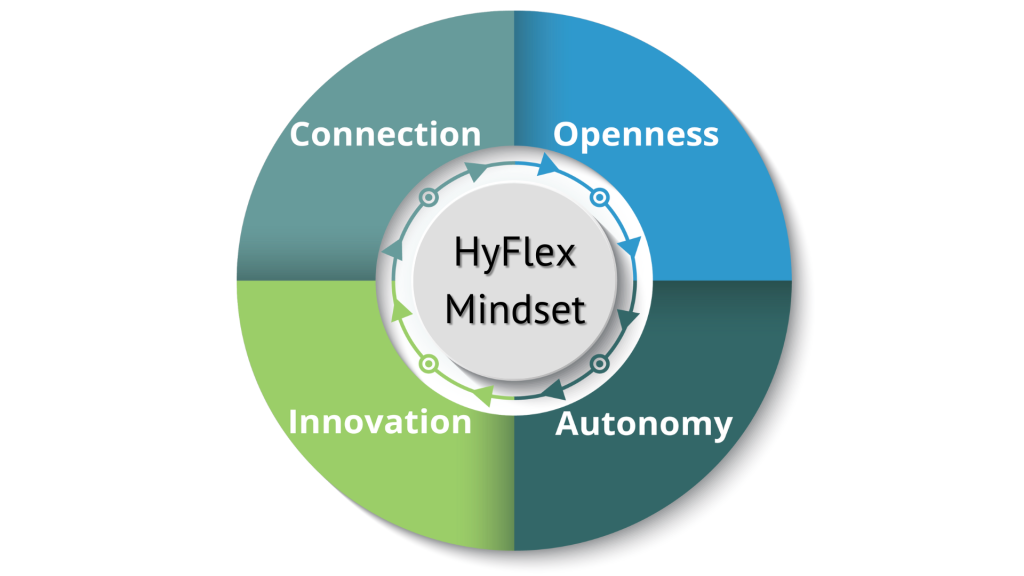Planning and Implementing
Implementation logistics
When designing for HyFlex implementation, it is important to consider all variables, such as logistics. There may be specific considerations for your context; however, most can be categorised under the headings of technology, faculty, and design.
Technology
The technology requirements will be crucial to implementing your HyFlex environment. You may design your environment based on institutional technology restrictions or choose to have the technology put in place for you.
For a hybrid / HyFlex environment, you will need technology integrated into your on-campus environment, preferably so that the online and on-campus students feel connected to each other and the faculty member.
In a less integrated environment, students will still need to have an online presence through effective technology that may not be fully synchronous with the on-campus cohort.
For a fully online HyFlex model, a range of educational technology tools may be required for teaching presence, interaction, and collaboration in mostly asynchronous mode. This is where starting with tools like Voicethread and Padlet provide a base for developing a toolkit appropriate to your learning and teaching needs and expectations within the HyFlex environment.
Check with your Information Technology department and Learning and Teaching advisors about the requirements you have to ascertain what they have and can provide.
Faculty
When organizing and designing curriculum and activities, the staff and students who will participate in the HyFlex experiences need to be considered.
Individual mindsets will impact the success of your implementation. If staff and students are open to trying new things, you are more likely to be successful. They will accept that not everything will work the first time and see this as part of the process rather than a reason not to continue.
However, consider whether the staff and/or students need support before, during, and after implementation. Also, determine how you will work with people who are the “noisy naysayers.” This can quickly disrupt any attempt to introduce new approaches. Come armed with examples and research to help counteract the negative responses in the initial stages and reinforce (ADKAR) positive progress.
Approaches to implementation:
- A staged pilot is recommended to build up positive experiences among faculty to share, discuss, and problem solve.
- Find and encourage some fellow champions of the idea (often ‘early adopters’ of technology). Doing this by yourself is hard and can be demoralising.
- Start a community of practice or find one to join. It is also helpful to involve management to get them on board to support innovation.
HyFlex Mindset
The adoption of a common mindset enables educator readiness and a capacity for and disposition towards HyFlex learning initially as an innovative idea and then as an embedded practice. A mindset (belief or disposition) is either the enabler or the barrier to new ideas and practices. The model shared here (modified from Lindsay & Redmond, 2022) suggests that an iterative process empowers educators to develop skills, enables participation in online activities, and potentially further influences pedagogical approaches and shifts practice.
Key attributes of the HyFlex mindset are connection, openness, autonomy and innovation. These collectively represent a foundational structure that is instrumental to innovative practices and change.

Connection: the attribute of connection and connectivity implies digital fluency and an ability to work in online and blended learning environments. Connectivity enables the educator to develop a network of like-minded colleagues supporting virtual working relationships by confidently applying both synchronous and asynchronous communication modes.
Openness: an educator who is “open” is understanding and receptive to other ways of knowing, as well as willing and able to adopt practices that embed sharing of ideas, resources and collaborations around learning. An open approach leads to a shift in pedagogy, a more flattened learning environment, less hierarchy in the learning process, and a shift in teacher-student relationships.
Autonomy: the attribute of autonomy relates to choice. An autonomous educator is able to make independent decisions in their learning environments about access to and use of digital and online technologies and the adoption of alternative pedagogies. More broadly, autonomy enables educators to be acknowledged as resilient leaders and risk-takers who cope well with change by adopting a flexible and agile approach.
Innovation: an innovative educator cultivates new approaches to learning among students and peers, with a focus on the sociability of learning, both online and offline. The focus is on processes, not just outcomes, for learning and assessment. Innovation in the HyFlex classroom when teaching and for learning is the new paradigm and is expected and acknowledged.
Design
Good design will help with implementation. Map out what you are doing and why. Identify the problem and let that guide your decisions. Always consider the user and design with an empathetic approach towards what they need and how you will support them.
When considering technology, faculty and design for your HyFlex innovation, working in collaboration and partnership with others will be essential. This includes the institution’s IT team and learning and teaching units (including learning designers and professional learning leaders). These partnerships could be crucial to success or at least to smooth stages of implementation.
Recommendations for Implementation
We have organised some key elements that we believe are necessary for successful integration under three approaches – Small, Medium and Full Scale.
References
Media Attributions
- HyFlex Mindset © Julie Lindsay is licensed under a CC BY-NC (Attribution NonCommercial) license

